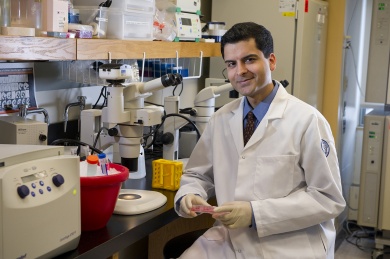The RNA code comes into focus
This is an excerpt of a feature that appeared in Nature. Read the full article here.
In 2004, oncologist Gideon Rechavi at Tel Aviv University in Israel and his colleagues compared all the human genomic DNA sequences then available with their corresponding messenger RNAs — the molecules that carry the information needed to make a protein from a gene. They were looking for signs that one of the nucleotide building blocks in the RNA sequence, called adenosine (A), had changed to another building block called inosine (I). This 'A-to-I editing' can alter a protein's coding sequence, and, in humans, is crucial for keeping the innate immune response in check. “It sounds simple, but in real life it was really complicated,” Rechavi recalls. “Several groups had tried it before and failed” because sequencing mistakes and single-nucleotide mutations had made the data noisy. But using a new bioinformatics approach, his team uncovered thousands of sites in the transcriptome — the complete set of mRNAs found in an organism or cell population — and later studies upped the number into the millions.
Inosine is something of a special case: researchers can readily detect this chink in the armour by comparing DNA and RNA sequences. But at least one-quarter of our mRNAs harbour chemical tags — decorations to the A, C, G and U nucleotides — that are invisible to today's sequencing technologies. (Similar chemical tags, called epigenetic markers, are also found on DNA.) Researchers aren't sure what these chemical changes in RNA do, but they're trying to find out.
A wave of studies over the past five years — many of which focus on a specific RNA mark called N6-methyladenosine (m6A) — have mapped these alterations across transcriptomes and demonstrated their importance to health and disease. But the problem is vast: these marks coat not only mRNA but other RNA transcripts as well, and they cut across all the domains of life and beyond, marking even viruses with their presence.
The modifications themselves are not new. What has given them meaning and driven epitranscriptomics into the spotlight is the discovery of enzymes that can add, remove and interpret them. In 2010, chemical biologist Chuan He at the University of Chicago, Illinois, proposed that these chemical tags could be reversible and important regulators of gene expression. Not long afterwards, his group demonstrated the first eraser of these marks on mRNA, an enzyme called FTO. That discovery meant that m6A wasn't just a passive mark — cells actively controlled it. And this realization came at about the same time that global approaches, harnessing the power of next-generation sequencing, made it possible to map m6A and other modifications across the transcriptome.
Today, epitranscriptomics is blossoming. Yet its toolbox remains a work in progress. Current methods lack the sensitivity required for use with rare and precious samples. It's also not possible to quantify the amount of a given modification in the transcriptome, nor to map more than one modification in a single experiment. “There's an urgent and high demand for additional technology developments for all kinds of RNA modifications,” says molecular biologist Tao Pan at the University of Chicago, who collaborated on He's FTO studies.
That said, epitranscriptomics researchers are excited about the direction their field is taking. “Just as you wouldn't think of DNA without thinking about how DNA is packaged, or epigenetically modified,” says geneticist Chris Mason at Weill Cornell Medical College in New York City, who has led m6A-mapping efforts, “I think now and in the future, no one will think of RNA without thinking 'How is it modified?'”
Mapping with antibodies
In the early 1970s, scientists first showed that mRNA was chemically modified by using radioisotope labelling of m6A. But because those studies enriched the mRNA transcripts by selecting their 3′ ends, which contain strings of adenosines, researchers worried that those preparations might contain trace amounts of other classes of RNA molecules, as well. “People stopped working on this because it was so difficult to get clear insights into whether the m6A in mRNA was a contaminant,” says Samie Jaffrey, a chemical biologist at Weill Cornell Medical College.
Also difficult was working out where in the transcriptome m6A was located, which could provide clues to its function. Conventional sequencing approaches involve reverse transcription — converting RNA into complementary DNA (cDNA), which is then amplified and sequenced. The problem is that the reverse transcriptase enzyme used to make cDNA erases the modifications. “There was no way to see m6A,” Jaffrey says. “When you reverse-transcribe it, it behaves exactly like an A.”
....
Despite the technical challenges, the discovery of unexpected bacterial RNA modifications piqued Jaffrey's interest, and he decided to look for them in mammalian RNA. Working with Mason, his team sheared RNA into tiny pieces, pulled out those that contained m6A using antibodies, and sequenced the RNAs. “We were clearly seeing labelling of mRNAs and that was remarkable. It was not a contaminant,” Jaffrey says. A similar study by Rechavi's group unearthed a hilly landscape of m6A peaks, roughly 12,000 sites in 7,000 human genes. The modifications, Rechavi's team discovered, tended to be concentrated on the protein-coding sequences called exons and on stop codons, the three-letter codes in mRNA that signify the end of the protein-coding sequence.
A parallel line of research has turned that finding on its head. Using an antibody-mapping method called miCLIP, which is higher in resolution than its predecessors, Jaffrey's team showed that its m6A antibodies also bind to N6, 2′-O-dimethyladenosine (m6Am), a modification of the chemical structures that cap the 5′ end of mRNAs. At the time, Jaffrey didn't know if m6Am carried any biological meaning. But his team has since shown that m6Am (and not m6A) is in fact the major target of the FTO eraser, and that it affects the stability and subcellular location of mRNAs. To Jaffrey, that suggests that He's findings linking FTO to acute myeloid leukaemia mean that m6Am, not m6A, is now implicated in the origin and development of cancer.
....




